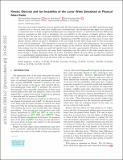| dc.contributor.author | Haakonsen, Christian Bernt | |
| dc.contributor.author | Hutchinson, Ian Horner | |
| dc.contributor.author | Zhou, Chuteng | |
| dc.date.accessioned | 2016-10-21T22:29:10Z | |
| dc.date.available | 2016-10-21T22:29:10Z | |
| dc.date.issued | 2015-03 | |
| dc.date.submitted | 2015-01 | |
| dc.identifier.issn | 1070-664X | |
| dc.identifier.issn | 1089-7674 | |
| dc.identifier.uri | http://hdl.handle.net/1721.1/104933 | |
| dc.description.abstract | The solar wind wake behind the moon is studied with 1D electrostatic particle-in-cell (PIC) simulations using a physical ion to electron mass ratio (unlike prior investigations); the simulations also apply more generally to supersonic flow of dense magnetized plasma past nonmagnetic objects. A hybrid electrostatic Boltzmann electron treatment is first used to investigate the ion stability in the absence of kinetic electron effects, showing that the ions are two-stream unstable for downstream wake distances (in lunar radii) greater than about three times the solar wind Mach number. Simulations with PIC electrons are then used to show that kinetic electron effects can lead to disruption of the ion beams at least three times closer to the moon than in the hybrid simulations. This disruption occurs as the result of a novel wake phenomenon: the nonlinear growth of electron holes spawned from a narrow dimple in the electron velocity distribution. Most of the holes arising from the dimple are small and quickly leave the wake, approximately following the unperturbed electron phase-space trajectories, but some holes originating near the center of the wake remain and grow large enough to trigger disruption of the ion beams. Non-linear kinetic-electron effects are therefore essential to a comprehensive understanding of the 1D electrostatic stability of such wakes, and possible observational signatures in ARTEMIS data from the lunar wake are discussed. | en_US |
| dc.description.sponsorship | National Science Foundation (U.S.) (Grant de-sc0010491) | en_US |
| dc.language.iso | en_US | |
| dc.publisher | American Institute of Physics (AIP) | en_US |
| dc.relation.isversionof | http://dx.doi.org/10.1063/1.4915525 | en_US |
| dc.rights | Creative Commons Attribution-Noncommercial-Share Alike | en_US |
| dc.rights.uri | http://creativecommons.org/licenses/by-nc-sa/4.0/ | en_US |
| dc.source | arXiv | en_US |
| dc.title | Kinetic electron and ion instability of the lunar wake simulated at physical mass ratio | en_US |
| dc.type | Article | en_US |
| dc.identifier.citation | Haakonsen, Christian Bernt, Ian H. Hutchinson, and Chuteng Zhou. “Kinetic Electron and Ion Instability of the Lunar Wake Simulated at Physical Mass Ratio.” Physics of Plasmas 22.3 (2015): 32311. | en_US |
| dc.contributor.department | Massachusetts Institute of Technology. Department of Nuclear Science and Engineering | en_US |
| dc.contributor.mitauthor | Haakonsen, Christian Bernt | |
| dc.contributor.mitauthor | Hutchinson, Ian Horner | |
| dc.contributor.mitauthor | Zhou, Chuteng | |
| dc.relation.journal | Physics of Plasmas | en_US |
| dc.eprint.version | Author's final manuscript | en_US |
| dc.type.uri | http://purl.org/eprint/type/JournalArticle | en_US |
| eprint.status | http://purl.org/eprint/status/PeerReviewed | en_US |
| dspace.orderedauthors | Haakonsen, Christian Bernt; Hutchinson, Ian H.; Zhou, Chuteng | en_US |
| dspace.embargo.terms | N | en_US |
| dc.identifier.orcid | https://orcid.org/0000-0002-8899-7479 | |
| dc.identifier.orcid | https://orcid.org/0000-0003-3796-7357 | |
| mit.license | OPEN_ACCESS_POLICY | en_US |
